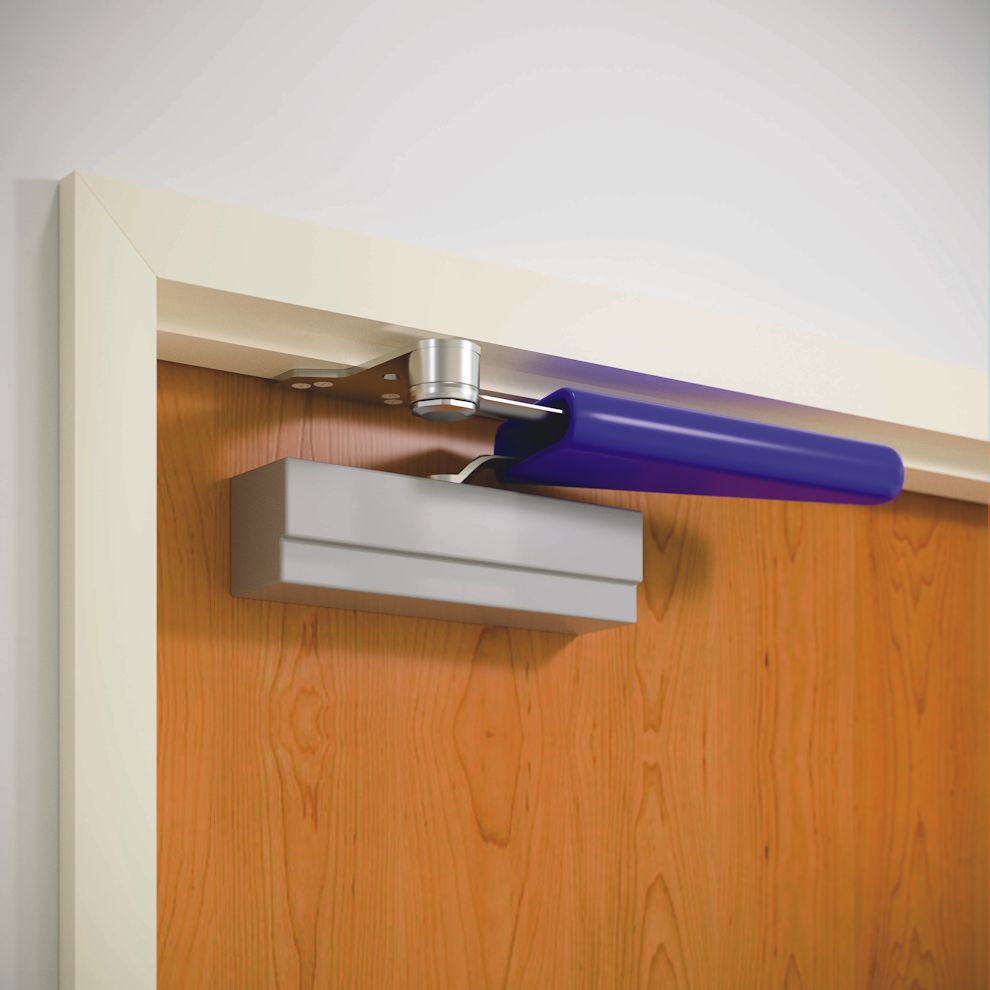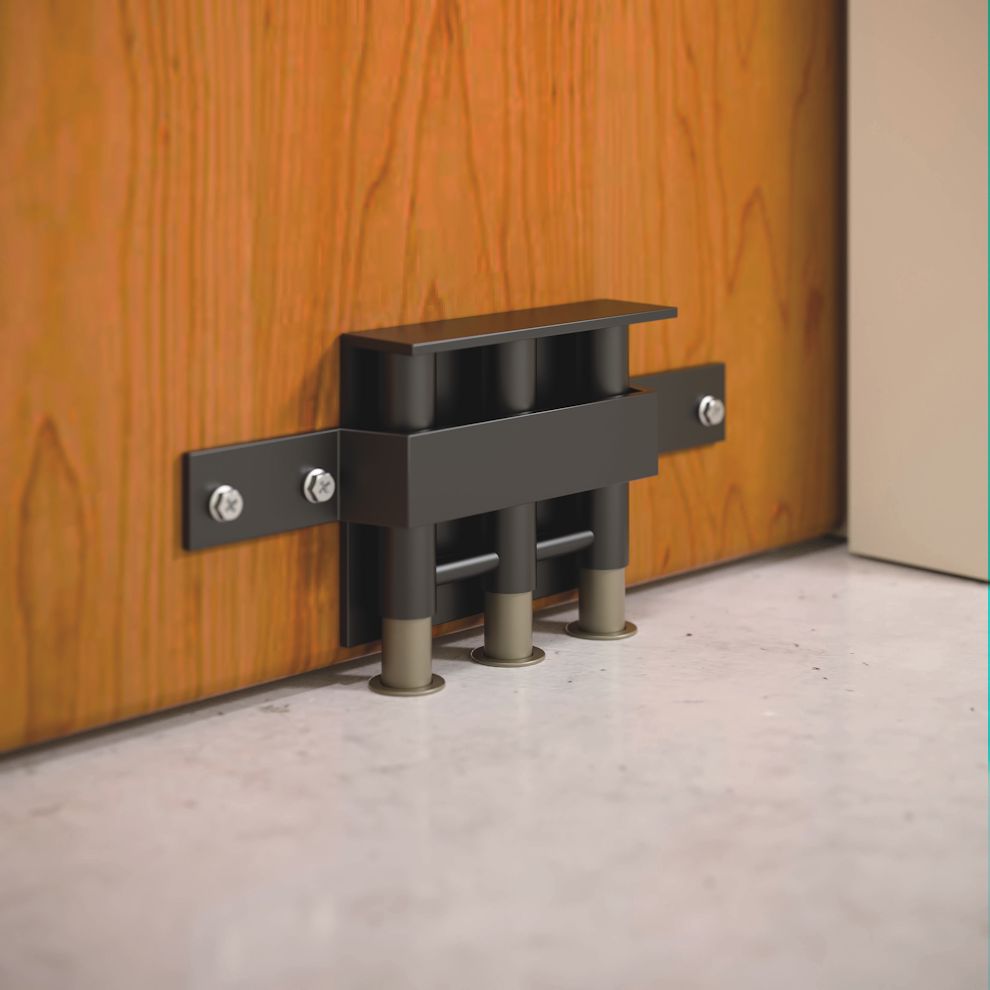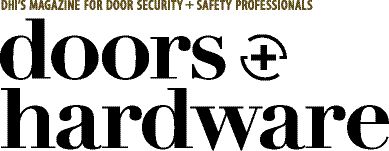This post will be published in the March 2017 issue of Doors & Hardware
.
[Click here to download the reprint of this article.]

The 2018 model code language prohibits modifications to panic hardware, fire door hardware, and door closers. Hardware used on fire doors must be listed for that purpose.
In case you haven’t been following the classroom barricade device issue closely, here’s an update. Within the last few years, products have begun to appear on the market which were advertised as a secure way to lock a classroom door during a school shooting. With school districts pressured to find a way to address their security needs quickly and within already-strained budgets, some districts considered retrofit security devices that were less expensive and easier to procure than new locksets. In some cases, locksets were already in place, but classroom barricade devices were touted as a way to provide additional security, address glazing adjacent to door hardware, or rectify a lack of established lockdown procedures or key distribution.
The problem with using retrofit devices to address insufficient security or procedures is that when installed on a door with existing latching hardware, most classroom barricade devices do not meet the model code requirements. The model codes that have been adopted in most US states include the International Building Code (IBC), International Fire Code (IFC), and NFPA 101 – The Life Safety Code. These codes currently require one operation to release the latch(es) on a door in a means of egress, with no tight grasping, pinching, or twisting of the wrist, and no key, tool, special knowledge, or effort. For fire door assemblies, all components must be listed for use on a fire door.
Faced with the egress requirements of the existing model codes, efforts were made by proponents of barricade devices to change the codes and relax the requirements that mandate free and unobstructed egress. Change proposals which favor security over egress cited a reduction in school fires as evidence that the stringent codes adopted to keep building occupants safe were outdated. On the contrary, many code experts credit the requirements of the model codes for drastically reducing fire deaths over the last 50 years.
In some states, attempts to change codes in order to allow retrofit security devices were driven by state legislators. In Arkansas and Ohio, legislators approved bills requiring code changes to be made, despite information provided by state code officials as well as organizations such as the National Association of State Fire Marshals (NASFM), the Partner Alliance for Safer Schools (PASS), and the Door Security and Safety Foundation (DSSF).

The model codes require all locks and latches on an egress door to be released with one operation; doors which require multiple releasing operations can deter evacuation.
In a few other states, code officials approved the use of some types of classroom barricade devices, if certain criteria were met. Other states issued bulletins clarifying that security devices which did not meet the model codes were not allowed. The majority of states did not make an official statement either way, relying on their existing state code requirements to ensure that locking devices used on classroom doors allowed free egress, were listed for use on fire doors (where required), and met the accessibility standards.
This mixed approach has resulted in inconsistencies from one state to the next, and even greater variations between school districts where conditional use of retrofit security devices is allowed. First responders could arrive on-scene without knowing what to expect and without the tools needed to access rooms equipped with classroom barricade devices. In addition to affecting evacuation, this can also impact a situation where an unauthorized person has barricaded the door with hostages inside, and there is no means of authorized access to the room.
In an attempt to create a safe, consistent set of code requirements for school security, the Builders Hardware Manufacturers Association (BHMA) Codes and Government Affairs Committee proposed a change to the IBC. After moving through the code development process, with input from the International Code Council and numerous other stakeholders, the change was approved. Similar language was later approved for the IFC, and a corresponding change is currently in progress for NFPA 101 – The Life Safety Code.
The 2018 edition of the IBC will include the following section to address school security:
1010.1.4.4 Locking arrangements in educational occupancies. In Group E and Group B educational occupancies, egress doors from classrooms, offices and other occupied rooms shall be permitted to be provided with locking arrangements designed to keep intruders from entering the room where all of the following conditions are met:
- The door shall be capable of being unlocked from outside the room with a key or other approved means.
- The door shall be openable from within the room in accordance with Section 1010.1.9.
- Modifications shall not be made to listed panic hardware, fire door hardware or door closers.
1010.1.4.4.1 Remote operation of locks. Remote operation of locks complying with Section 1010.1.4.4 shall be permitted.
The key points in this code change are:
- This language applies to K-12 schools, colleges, and universities.
- The requirements apply to classrooms and also to offices and other occupiable rooms.
- If the rooms are lockable, they must be able to be unlocked from the outside with a key or other approved means.
- Locks are not mandatory, but if locks are used, the doors must meet the requirements for egress – one operation to unlatch, no key, tool, special knowledge, or effort, and no tight grasping, pinching, or twisting of the wrist.
- Listed panic hardware, fire door hardware, and door closers must not be modified.
- Remote operation is acceptable if the locks meet the other requirements of this section.

When the new requirements are adopted, lockable doors in educational occupancies must be capable of being unlocked from the outside with a key or other means approved by the building official.
Revised code language will be included in the 2018 editions of the model codes, which will go into effect when adopted in a particular state or jurisdiction. That could mean several years or even a decade for the new language to become effective across the US. But there are two pieces of good news:
- The bulk of this code language is already included in the current (and past) model codes. Normally, it would not be necessary to reiterate information that’s stated in another section of the code, but it is important that these requirements be perfectly clear. The reference to information that has been in the codes for many years underscores the importance of maintaining these existing requirements. The only new criteria for school security is that doors which are able to be locked must be able to be unlocked from the outside using a key or other approved means. Note that “approved” means “acceptable to the building official.”
- States may adopt the new language ahead of adoption of the entire 2018 model code. This offers a consistent alternative to individual state code changes. This “pre-adoption” recently occurred in North Carolina, where the NC Building Code Council received a proposed change which would have allowed “emergency lockdown safety mechanisms” in schools and office buildings. Instead of approving this change, the Building Code Council adopted the 2018 model code language addressing school security.
As code changes favoring barricade devices are proposed in other states, it’s important for the officials responsible for considering the change to be aware of the 2018 model code language. Rather than adopting code language that is specific to each state and may conflict with the model code requirements, adopting the approved 2018 language will lead to increased consistency and continued protection of the means of egress. This will help to ensure that free egress and life safety are considered when selecting security devices; there are many locks available which provide the necessary level of security and also meet the model code requirements.
Is your state or local jurisdiction considering a change? Find out and alert BHMA or the DSSF, so information on the 2018 language can be shared as another potential option.
You need to login or register to bookmark/favorite this content.






Leave A Comment